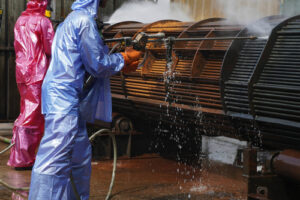Immersion Heaters & Why Adequate Heat is Vital for Caustic Solutions
Last updated on April 23rd, 2025 at 04:53 am
Caustic solution products such as soap and candles may seem insignificant, but they undergo a delicate and thorough process to meet industry standards. Sufficient heating is a significant component of this process and requires the proper heating units to make it possible. This post will examine the role of heat in caustic solutions and the machinery needed for these products.
Caustic Application Examples
 Industrialists label any compound that burns or corrodes through chemical reactions as caustic solutions. The manufacturers of caustics use sodium hydroxide (caustic soda) at high temperatures to trigger the reactions needed to make caustic products.
Industrialists label any compound that burns or corrodes through chemical reactions as caustic solutions. The manufacturers of caustics use sodium hydroxide (caustic soda) at high temperatures to trigger the reactions needed to make caustic products.
Other processes may involve the use of potassium hydroxide and calcium oxide. Nevertheless, this process results in a slew of everyday products (and solutions).
Common Caustic Problems
- Paper production – Converting wood to paper relies on caustic chemical processing. Compounds treat the wood, dissolving unnecessary materials and leaving cellulose intact, which is the main component of paper. Caustic chemicals also help remove ink from paper during the recycling process.
- Cleaning products – Household cleaning products ranging from laundry detergents and bleach to body soaps fall in the category of caustics. Other items such as drainage cleaners also fall under the label of caustic products.
- Medicine – The medical (and pharmaceutical) industry uses caustics such as over-the-counter and prescription drugs. They include the likes of aspirin, blood thinners and statin drugs.
- Textiles – The production of various materials requires caustic solutions. They include the likes of rayon, spandex, cotton and more. These chemicals also help create dyes and are used for bleaching purposes.
- Water Treatment – Water treatment facilities often use caustic chemical processing to balance water acidity. They also use these solutions to sift heavy metals from water and disinfect it.
Ultimately, what truly gives caustic solutions their power is the heat that industrial operators apply to these processes.
Caustic Heating Requirements
Caustic soda processing- which takes place in a caustic tank – must occur at temperatures above 70 degrees celsius. Lower temperatures will not activate the necessary chemical reactions, while too high temperatures will degrade the soda. Balance is essential.
With that said, heating for caustic solutions often involves a few elements. There is a heating tape, an electrical cable that transfers heat through the caustic tank. That prevents the freezing of the solution.
There are also steam coils that use air moisture to create heat, which, in turn, helps keep caustic tanks hot. Lastly, heat exchangers can be installed in a tank to circulate heat using air.
Immersion Heaters for Caustic Solutions
Using an immersion heater for caustic solutions offers a fast and efficient means to keep caustic soda at suitable temperatures. They heat liquids quickly, including the compounds used in caustic solutions, without leaving residue.
A bonus is that an immersion heater is environmentally friendly and requires minimal maintenance. Ideally, an indirect immersion heater for caustic solutions is ideal since direct ones can cause corrosive damage to caustic tanks. That said, we provide industrial-grade immersion heaters for water, oil and caustic chemicals in various settings and environments.
Are you looking for an immersion heater for caustic solution processing? Get in touch with us for a quote.
